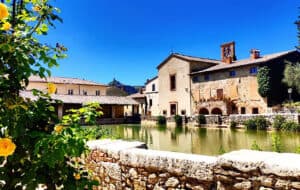Tuscany is not only rolling hills, good food, and excellent wine: it can also be a totally relaxing stay. In fact, all over our region there are many different kinds of natural hot springs of volcanic origin.
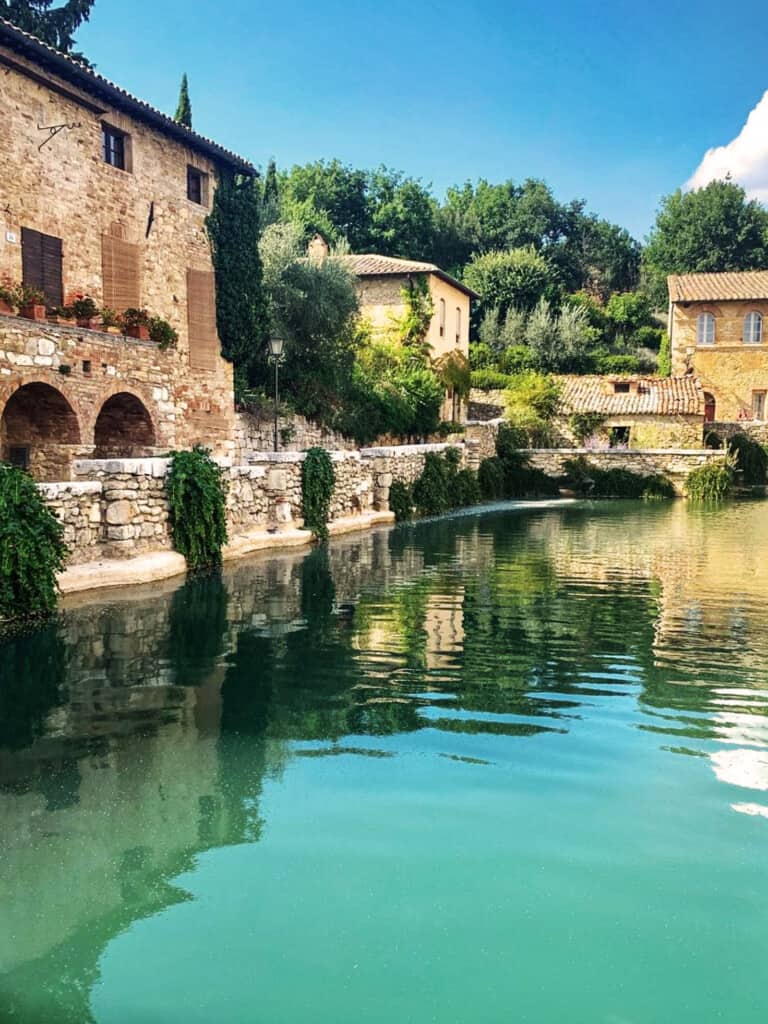
Thanks to Monte Amiata, the ancient dormant volcano that dominates the southern horizon, the province of Siena is the richest area in Tuscany for natural hot springs. The great thing is that, in every thermal town, you can go to luxury spas or you can have a wild and free soak surrounded by nature! The following are our 9 best Thermal Destinations in Tuscany...
Bagno Vignoni
One of the oldest and most popular spas in this area is definitely Bagno Vignoni, a tiny village in the middle of the Val d’Orcia. It is famous for the Roman hot spring pool in the middle of the main square whose thermal waters of volcanic origin flow in from an underground aquifer. There are a few spas right in town, Hotel Posta Marcucci and Hotel Le Terme, but the most exclusive and chic is the Adler Spa Resort Thermae, a stone’s throw from the town and just stunning!
Bagni San Filippo
Not far from Bagno Vignoni, closer to Monte Amiata, is another lovely place, Bagni San Filippo, a small town known since ancient times for the warm thermal waters that have created a magical landscape of white limestone formations, waterfalls, and small hot tubs where you can bathe in the middle of the lush green forest. After walking along a path in the woods, you come upon the so-called ‘Balena Bianca’ (White Whale), a huge impressive block of limestone formed by the sediment of the white hyperthermal water. Along the way, you can find naturally-formed small pools at the bottom of which lies a precious thermal mud used in skin treatments. After a relaxing soak, you can replenish your empty stomach at “Osteria lo Spugnone”, a traditional Tuscan restaurant featuring local products.
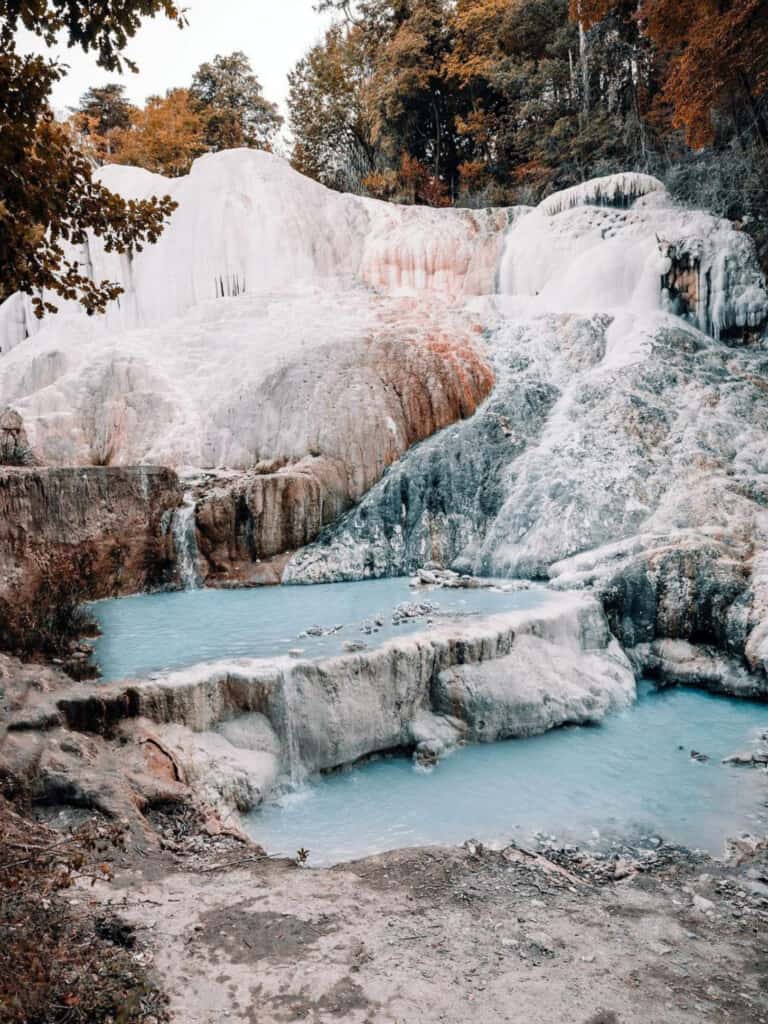
San Casciano dei Bagni
Just a 30-minute drive away, there is San Casciano dei Bagni. The village was specifically founded to capitalize on its 42 thermal springs, which clearly indicates the primary importance of the beneficial spring waters in the history of this tiny village. These thermal baths were known and used first by the Etruscans and then by the Romans, also thanks to their location along the Via Cassia and their relative proximity to Rome. ‘Fonteverde Tuscan Resort & Spa’ is a 5-star resort, very popular for its Bioaquam path with 22 different kinds of hydromassage and for its wonderful view over the Val d’Orcia. Here in San Casciano, you can also enjoy a wild and free soak in the natural pools close to the town where you can take a dip all year long.
Rapolano Terme
Leaving the Val d’Orcia and heading towards the ‘Crete Senesi’ territory, an important hot-spring area is Rapolano Terme. Here, the abundance of thermal waters and springs led to the construction of two spas, the Terme di San Giovanni and the thermal complex of Antica Querciolaia. The first features a 39°C (about 102°F) thermal pool and a wellness and beauty center with hot tubs, sulphur baths, mud baths, aqua fitness, and various other possibilities. Enjoying the sunset on the gentle hills from the outdoor pool is a must! Antica Querciolaia offers indoor and outdoor thermal pools of different temperatures for hot and cold thermal experiences.
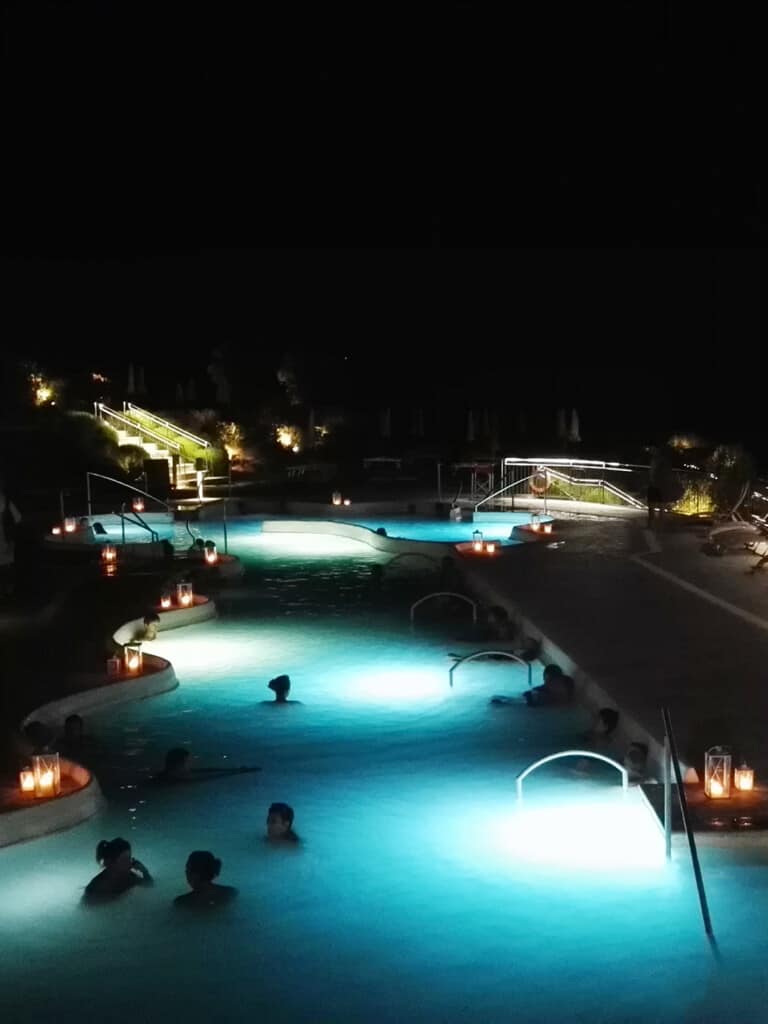
Chianciano Terme
Between the Val d’Orcia and the Val di Chiana, one of the oldest thermal traditions is in Chianciano Terme, whose spas and properties were already known by the Etruscans and Romans. The spa tradition of the area continued over the centuries until the construction of the first modern establishments in the 1920s. From that moment on, Chianciano flourished with decades of thermal tourism and good business until it lost a bit of its glory falling behind the other thermal areas. But the most recent addition is absolutely beautiful. The ‘Sensory Spa’ is inspired by oriental philosophies and offers holistic treatments to rebalance both the spirit and the body!
Petriolo
Between Siena and Grosseto there is probably the most popular natural free spa in Tuscany, Petriolo. The precious thermal waters of Petriolo gush out on the little Farma River at a temperature of 43°C (109°F). These waters have a high concentration of limestone and sulfur. Thanks to these two elements, natural pools that collect the flow of water have formed over time. The nice thing about this place is that you can switch from the hot water of the pools to the fresh and clean water of the Farma River in a quick jump!
Saturnia
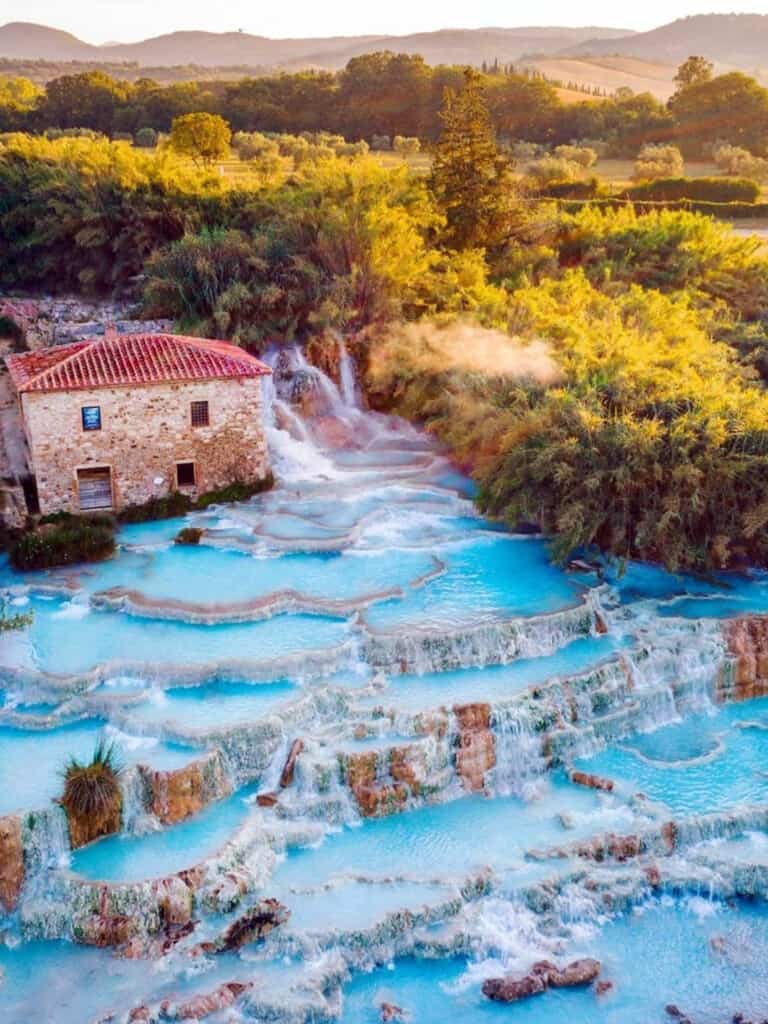
The most famous hot spring of our region, Saturnia, gushes up in the middle of nowhere in one of the wildest parts of Tuscany. If you have ever seen a photo of Tuscan spas, you have most likely seen a picture of the “Cascate del Mulino” where the 37°C (97°F) water fills its natural limestone pools. If you have a flashlight with you, don’t miss out on taking a dip at night in the moonlight… a truly enchanting experience!
Hot Springs along the Tuscan Coast
Going up north towards Livorno on the Tyrrhenian coast, there are two more hot spring areas: Venturina Terme and Sassetta, both lovely and in perfect locations to enjoy hot springs with cooler waters nearby (the sea is only few kilometers away) and excellent wines from Bolgheri, the famous Super Tuscan!
Hot Springs in Northern Tuscany
Last but not least, the northern part of Tuscany also has a concentration of thermal waters between Pisa and Pistoia. The location can be great for visiting the nearby cities of Pisa and its Leaning Tower or the wonderful Lucca surrounded by its perfectly preserved Renaissance walls and famous for its unique oval shaped square, Piazza dell’Anfiteatro.
In Montecatini, the hot springs were already famous in Roman times, but it is mostly thanks to the Grand Duchy of Tuscany that we can still enjoy them today. The Montecatini spa area is among the most developed in Europe counting nine buildings and featuring one of the most complete thermal offerings to cure many different conditions. Terme Tettuccio is probably the best – the building is stunning and it feels like you are in an ancient Roman palace!
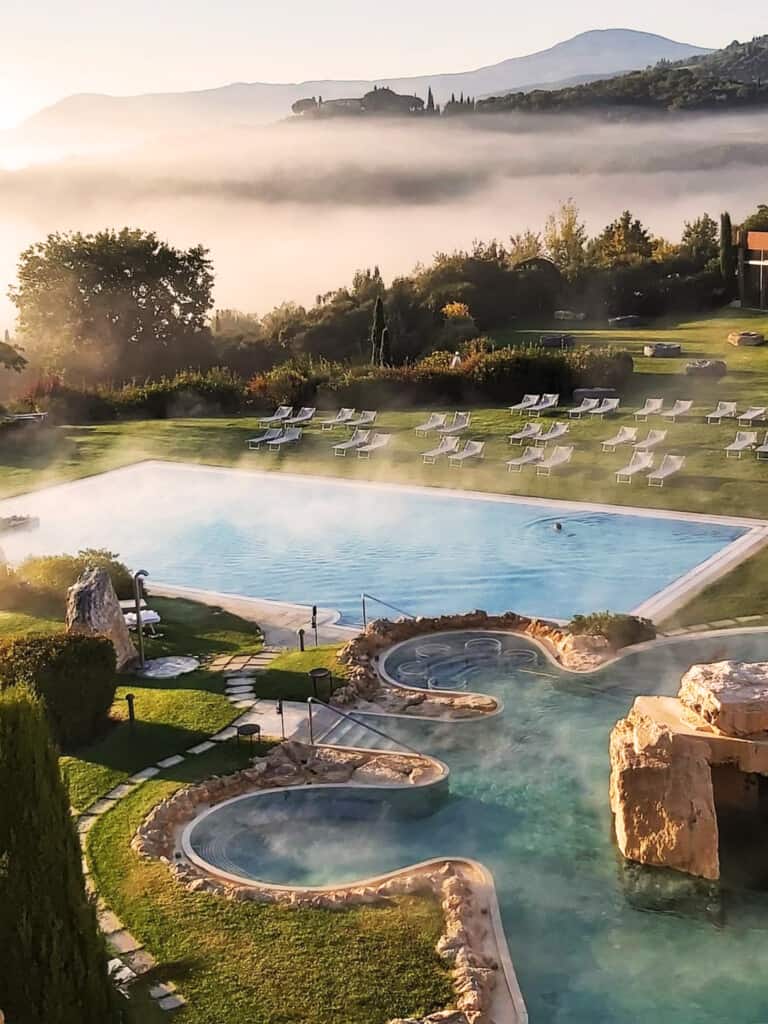
Just five kilometers (3 mi) away from Montecatini, hot springs were discovered more recently (so to speak) in Monsummano. Grotta Parlanti was discovered at the end of the 1700s while the famous Grotta Giusti was only discovered in 1849 just by chance. Both are named after the owners of the land where they were found.
Thermalism in the History
There has always been a physical and spiritual relationship between man and water. Many cultures used the therapeutic properties of mineral waters over the centuries.
Hippocrates, Greek physician and geographer considered the father of medicine (about 460 BC – 377 BC), dedicated a great part of his studies to water in a scientific and contemporary way: its chemical and organoleptic characteristics, hygiene issues, the use of hot springs for various diseases, as well as the effects of hot and cold springs on the human organism.
In ancient Rome, the thermal phenomenon developed exponentially clearly involving the building industry. Above all, it brought hygiene into this part of the home with connotations of social and cultural order. Many Roman houses began to designate a room as the bathroom, initially cold then heated, and expanded on it with rooms for complementary uses (sauna, massages, and relaxation).
During the Empire, grandiose spa buildings, whose ruins can still be admired today, were constructed representing a social institution of that time. Spas were open to everyone: all Romans frequented them regardless of their social class. The “thermal culture” of the imperial period later led Rome to also make use of the springs for specific therapeutic benefits.
The XVIII century was a turning point in hydrology thanks to the scientific development of medicine and the beginning of modern chemistry, which made the first analyses of the composition of mineral waters possible. Between the XIX and XX centuries, it was the economic and cultural elite who went to the spas and only later did this phenomenon extend to the middle classes.
Today, spas closely collaborate on research with universities and are constantly updated on new acquisitions, methods, and therapeutic protocols, and hot spring water is considered part of the medical treatment plan. Each type of water has different healing properties. Some are used for the treatment of rheumatism, inflammation of the respiratory tract, and gynecological pathologies, while others are specifically suited for skin diseases.
Of course, you do not need to have any of these problems to enjoy a nice hot dip! So, why not soak in some of our beautiful spas and soothe your body and your soul as well?
